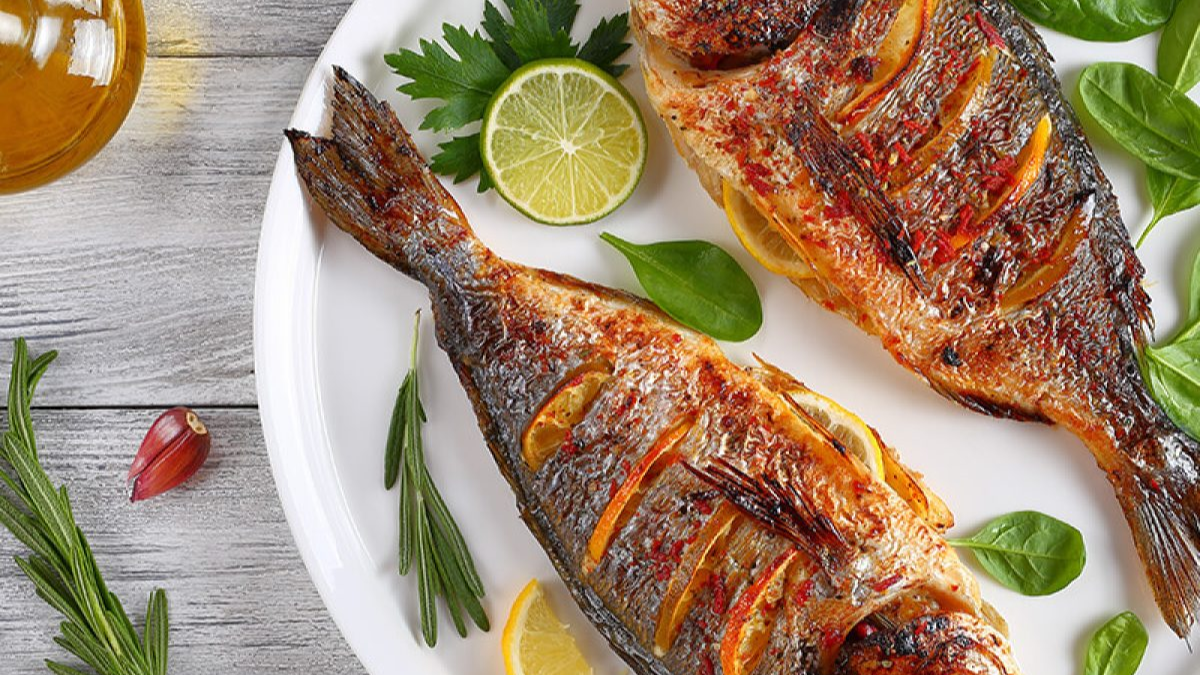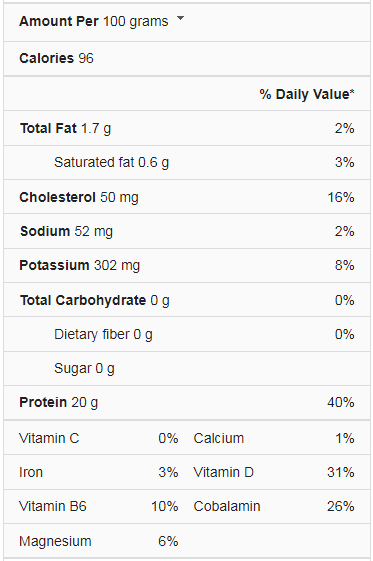Fish meals can be made in an air fryer in a healthy, delicious way. The fish produced by air fryers is crispier and tastier than ever since, in contrast to traditional ovens, they require much less oil. White fish filets with a mild flavor, such as tilapia or cod, are used to make air-fried fish and are perfectly portioned. In the air fryer, the fish is cooked to a beautiful golden brown and crunchy crust made of seasoned breadcrumbs. Fried fish cooked in an air fryer uses less oil and has a delicious flavor while low in calories.
With an air fryer, frying fish at home is simpler than ever. An air fryer may cook frozen or fresh fish; the dish will taste as it came from your favorite seafood restaurant. No minor burns from hot oil splashes or extra calories from cooking it in fat are a concern.
Fish Nutrition Facts (Tilapia)
What is Fried Fish?
Any fish that is prepared by frying as opposed to grilling, baking, or cooking method is often referred to as “fried fish.” However, it is exceptionally typical for the fish to be battered or coated in some other way before being fried. Such fish can be cooked by itself. Although both heavy and light batters are famous, the type of such batter or coating frequently varies depending on regional or cultural culinary traditions. Fried fish can be consumed independently, often paired with other side dishes, or used in other recipes like sandwiches and tacos.
Although there are many various ways to prepare fried fish, in general, the fish is usually cooked by being fried in heated oil. This can be a shallow fry, in which the fish must be turned over at least once while cooking and a little exposed to the oil. Fish can also be deep-fried, and this method is frequently used for fish that has been battered or otherwise given a coating of some kind. While butter can be used to cook fish in place of oil, this preparation method is more frequently used to cook baked or grilled fish.
How to Fry Fish in an Air Fryer?
Here is the best air-fried fish recipe:
Ingredients
- 4 Tilapia filets
- 1 tsp chili powder
- ½ tsp garlic salt
- ½ tsp pepper
- ½ tsp salt
- 1 cup breadcrumbs
- 1 /2 cup all-purpose unbleached flour
- Two large eggs
- Two tablespoons of cold water, a splash
- Cooking Spray
What is the Healthiest Way to Cook Fish?
Grilling and Broiling
The cooking techniques of grilling and broiling are similar, and both entail cooking your meal dry at extremely high temperatures. Grilling and broiling apply heat; and; however, the gang does so from below while broiling does so from above. Both techniques offer a quick and fat-free way to prepare delicious fish. Unfortunately, it has been established that both grilling and broiling might result in the creation of some dangerous substances known as heterocyclic amines (HAs) and polycyclic aromatic hydrocarbons (PAHs).
When muscle tissue from beef or fish is cooked to extremely high temperatures, typically over an open flame, these two types of chemicals are created. But only high red or processed meat diets have been connected to the dangers of these chemicals, and fish consumption has not been linked to the same risks.
Additionally, grilling and broiling may cause the development of substances referred to as advanced glycation end products (AGEs). When heated to high temperatures, these substances can also develop in foods containing muscle, such as meat and fish. These compounds naturally grow in your body as you age.
Pan-Frying and Deep-Frying
Hot fat is used in high-temperature cooking techniques like pan and deep frying. In contrast to pan-frying in a skillet, wok, or pot, deep-frying requires submerging food in a significant amount of fat.
- Fish absorb some of the fat while being fried, changing the type of fat it contains and adding calories.
- When fish is cooked in oil with a lot of omega-6 fatty acids, like vegetable oil, the amount of inflammatory omega-6 fatty acids in the fish increases.
- Due to the higher volumes of oil used while deep-frying fish as opposed to pan-frying, it has been demonstrated that this occurs to a greater extent. Leaner fish generally absorbs more oil than fatter fish.
- Additionally, frying at high temperatures degrades fish’s beneficial omega-3 fatty acids more than other types of cooking.
- For example, one study discovered that frying tuna reduced the quantity of healthy omega-3 fatty acids by 70 to 85%.
- However, it appears that these outcomes can change according to the type of fish you cook. According to other studies, some fish, like herring, may still contain beneficial quantities of omega-3s after being fried. Other nutrients may also be in danger because, according to one study, cooking salmon lowered its vitamin D content by 50%.
The hazardous substances, PAHs, and AGEs may form in more significant quantities due to the high temperatures used in frying. Because it uses less oil than deep frying, pan frying is often thought to be healthier. The selected oil should be stable at high temperatures and offer beneficial fats to your fish, and one nutritious choice is olive oil.
Poaching and Steaming
Cooking techniques that use water or other liquids during the cooking process include poaching and steaming. Poaching entails immersing fish in a liquid such as water, milk, stock, or wine when cooking fish in the oven.
Using hot, vaporized water to cook your fish, steaming is frequently done in a pot or device built for the purpose. Neither poaching nor steaming the fish adds oil or fat, so employing these techniques won’t increase your fish’s calorie count or alter its fat composition. In addition to helping to conserve nutrients, poaching and steaming fish also cook it at somewhat lower temperatures than other techniques, which are thought to lessen the creation of dangerous compounds like HAs and PAHs.
According to one study, the additional cooking time needed to steam salmon may result in more cholesterol oxidation products. When cholesterol is cooked, some potentially dangerous chemicals are created. However, due to their lower temperatures and lack of cooking oil, steaming and poaching are considered healthful techniques for preparing fish (compared to other methods).
Baking
Fish is cooked using a dry heat technique called baking in an oven. According to several research studies, baking fish results in a lower loss of omega-3 fatty acids than frying or microwaving, and fish’s vitamin D content may be better preserved through baking.
According to one study, fried salmon loses around half its essential vitamin D while baked salmon keeps all of it. These factors make baking fish in the oven a healthy cooking method. However, like other cooking techniques, frying your fish in oil might alter its fatty acid composition. Use just little amounts of a nutritious, heat-stable oil, such as olive oil, while baking fish.
Microwaving
Energy waves are used in microwave ovens to cook food, and food is heated due to these waves’ interaction with some molecules. This cooking method could be debatable because some think using a microwave can lower the number of nutrients in meals. However, cooking in the microwave is quick and done at a low temperature, and it can keep some nutrients better than other cooking techniques.
Numerous studies have revealed that microwaving fish can aid in preserving its beneficial omega-3 fatty acids.
In addition, compared to other cooking techniques, such as frying, lower temperatures indicate that dangerous substances like PAHs and HAs are less likely to occur.
Storage Tips
Storing your food correctly is essential to prevent spoiling or food poisoning.
- Refrigerate: Let any air fryer fried fish leftovers cool entirely. Then store them in an airtight container or Ziploc bag in the refrigerator for up to 3 days.
- Reheating: Reheating air-fried fish in the air fryer is super easy and beats reheating in the microwave. To bring your fried fish back to almost perfect crispiness, put your pre-cooked fish back into the air fryer and cook at 400ºF for 1-2 minutes or until heated through. Your fish fingers should be crunchy, soft, and flaky inside.
Fish cooked in an air fryer is delicious when served with homemade tartar sauce and a potato side dish. We enjoy air-fried tater tots and crunchy air-fried fries.
Conclusion
Fish is an excellent complement to any diet because it is a healthful food. The nutrition profile of your fish can be impacted by the type of fish you use, your cooking technique, the amount of time you cook it, and the cooking oil you use. Overall, the healthiest cooking techniques reduce the development of dangerous chemicals, maintain the most nutrients, and prevent the loss of beneficial omega-3 fats.
Fish can be cooked so well in an air fryer, and the fish cooks up crispy and is juicy and flaky. Additionally, you can complete it quickly without watching the fish or worrying about oil spills. You can now prepare this crispy battered fish at home in an air fryer! And it’s so quick and easy!



